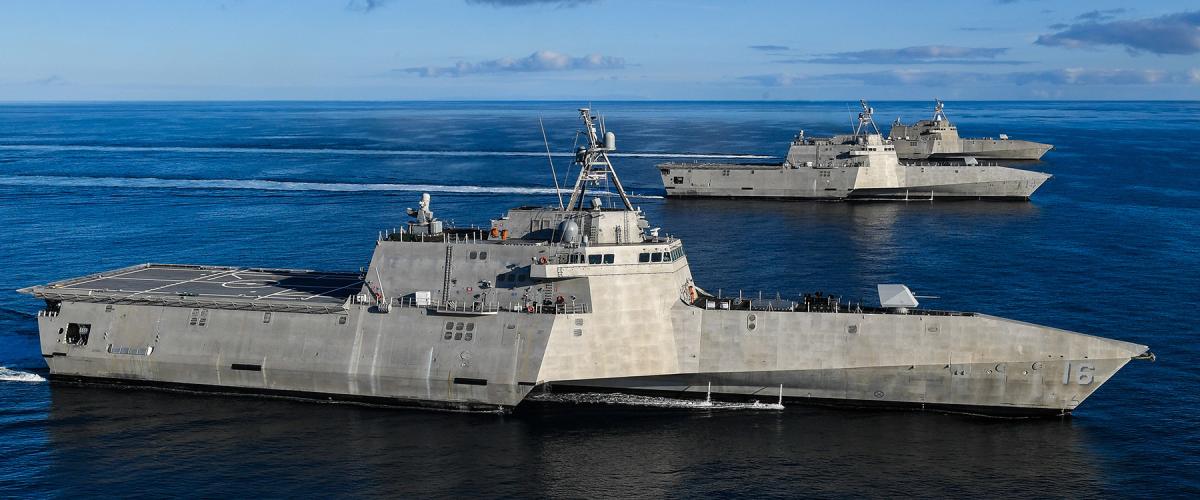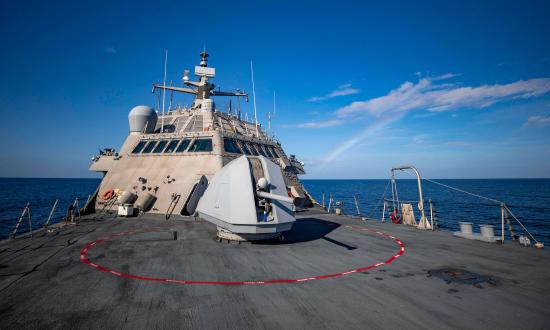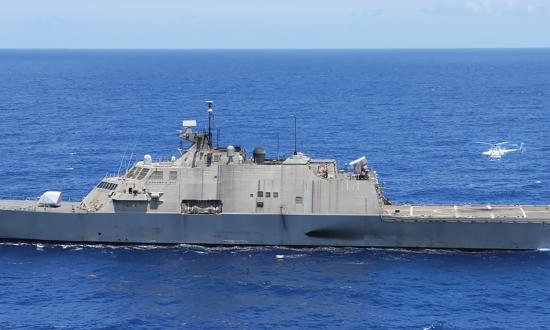Just as only Nixon could go to China, perhaps only someone who has written more than a dozen articles in favor of littoral combat ships (LCS) can say what went wrong with them. Foreign observers and the other critics have commented on the problems with the LCS program for years while missing the deeper issues that ultimately resulted in its failure. Though the mission modules have taken a fair amount of criticism, the systemic failures of the LCS program were primarily because of:
- The mass of new systems and equipment fielded in the class that were undigestible within the acquisition and test and evaluation system
- The high-speed requirement that took away weight/space that could have been used for other capabilities
- The surface navy’s love/hate relationship with LCS, which destroyed any chance of assistance from much of the institutional leadership of the surface force
The LCS will no doubt be a case study in challenge and failure, but future scholars should understand the specifics. Much like the Casco-class monitor of the late Civil War era, LCS started with a good idea. However, the engineering was immature and the concept of operations too foreign to the existing surface navy to succeed. The bottom line, however, is grim. The LCS program objective to field a modular mission small combatant that could be deployed and operated overseas at lower cost than conventional warships did not succeed as desired and should be studied to prevent similar errors in ship design, construction, fielding, and operations in the future.
Too Many New Things Breaks the Acquisition System
The 1960s-era DoD acquisition system and its 1970s/1980s operational test and evaluation subsystem, along with further reforms at the outset of Secretary of Defense Donald Rumsfeld’s term (2001–06), created the framework through which all Navy programs—from individual weapons to whole ship classes—must navigate. That system generally supports evolutionary and not revolutionary programs. Many test and evaluation “wickets” within the acquisition system require mature and reliable equipment to pass and move forward toward initial operating capability. The basic LCS hull, known as the sea frame, had issues with hull cracking and propulsion plant design from the start. Many mission module components were immature or, like the 1990s-era Remote Mine Hunting System (RMS), struggled to pass testing before being cancelled. Testing failures add time to the program, delay system progress, and ultimately increase cost. The first two LCSs more than doubled in cost from 2005 to 2008. The program was paused and restructured following the commissioning of the first two ships, but did not give the immature modular equipment time for fine-tuning ahead of testing. Fewer revolutionary systems might have allowed LCSs to get into commission faster and fix the remaining bugs before the cost of the individual sea frame became overwhelming.
Speed Kills in More Ways than One
The original incarnation of the LCS, the very small and disposable “streetfighter” warship, relied on a high-speed component as part of its concept of operations that included hunting down and destroying light forces. That high-speed element continued even after the basic LCS design was substantially modified by Chief of Naval Operations (CNO) Admiral Vern Clark to one that was much larger and included a helicopter flight deck and hanger. While the percentage of weight required to achieve high speed in the original did not detract from its sensors and weapon systems, getting the same high speed from a much larger ships did affect the design in multiple ways—including the number and weight of weapons, sensors, fuel, and other key mission components. The fleet could have sustained an LCS with a large rotary wing hangar and flight deck had its hull and propulsion system been more conventional.
The waterjet propulsion plant for both LCS variants, but especially for the semi-planning monohull LCS-1 (Freedom) type, has proven unreliable in service. Its combining gear system—which takes inputs from two diesel and two gas turbine engines to create a unified propulsion input—was overly complex, difficult to maintain, and plagued with problems in active service. While a fix to this system has been engineered, it has come too little and too late for critics and supporters alike. It is arguable that, had LCS possessed a reliable propulsion plant and effective operational range as promised, opposition to the class and its variants would have been less vitriolic.
The Surface Navy Did More Harm than Good to LCS
The surface navy has a love/hate relationship with LCS going back to the earliest days of the program in the late 1990s. The champions of the LCS streetfighter concept were Office of Force Transformation leader Vice Admiral Arthur Cebrowski and Naval Postgraduate School Tactics professor Captain Wayne Hughes. Cebrowski was a naval aviator who thought streetfighter was expendable and could be abandoned by its crew if necessary, while Hughes thought of the concept as a small cruise-missile combatant that could be produced in large numbers. The streetfighter was a very small warship with a few missiles as armament and a micro crew whose mission was to fight until their weapons ran out or they were damaged to the point at which they might abandon the ship rather than repair it and return it to port.
The conventional surface navy was uninterested in either of these ideas. CNO Clarke, a surface warfare officer who had commanded a gunboat-sized ship in the 1970s, made the decision to make LCS a much larger and in some ways more conventional surface warship. The concept gained considerably more size when it added large, rotary-wing aviation facilities. However, the new LCS was not like conventional small warships such as the Oliver Hazard Perry–class frigate. It still had a very small crew, rotational crews, lots of new equipment and operating concepts, and lacked a specific sponsor until the Program Executive Office (PEO) for the class was established in 2011, more than two years after the first ship of the class was commissioned. Hughes and other supporters of the small missile-craft concept distanced themselves from the frigate-like LCS.
The LCS concept of operations still tried to do much of what the streetfighter was supposed to, but also acted much like past small combatants in terms of appearance and mission. The LCS had a lot less crew than an FFG-7, conducted most of its maintenance through off-board means, and some of its equipment was still being exclusively serviced by contractors and not sailors. It also took time for the Navy to create a dedicated LCS crew-training program. Before that, the surface navy tended to treat LCS like another Perry-class frigate or even an Arleigh Burke–class destroyer in terms of readiness issues.
The strategic rationale of a unipolar world in which LCSs would “mop up” the remnants of a low-end opponent’s maritime forces not killed by high-tech “net fires” also changed with the world returning to competition between peer navies. It is much easier to return a high-end platform like the Arleigh Burke (DDG-51) from constabulary-like duties to its fleet combat function than it is to upgrade a low-end, constabulary combatant to major combat roles even if its modular design would support some modification. In a fleet that measures surface warship utility in its vertical launch battery alone, a ship like the LCS will always be seen as an outsider—even if produced in numbers.
Given the LCS’s outsider status from the beginning, it is questionable if navy surface ship leaders saw the LCS as even fitting within existing Navy operational constructs and patterns. Its endurance was too low to stay with a carrier strike group or amphibious ready group for any period without significant refueling. It did not fit within the operational constructs of those formations either, as it lacked significant air and surface warfare capabilities. The LCS’s off-board maintenance pattern did not fit with traditional Navy concepts in which sailors either repair their own gear or rely on uniformed Navy personnel vice contractors to come on board and complete maintenance. As a result, the LCS was viewed by many in the surface community as a less-capable destroyer or Perry-class frigate rather than as a unique surface combatant.
Observations
While critics continue to focus on the technical challenges of the LCS program, it is also useful to remember its cultural differences with the rest of the surface navy. This is unfortunate, as the Navy must confront many operational requirements in its global mission set, and not all of those involve firing salvos of cruise missiles or providing air and missile defense to high value units. In a Navy that thinks only in terms of the value of Aegis units, the phase zero shaping operations, maritime security, and missions outside the immediate Indo-Pacific theater ideal for an LCS seem irrelevant and not worth investment. LCSs retired early and could be recommissioned in the event of a major conflict when more ships are required.
The creation of a dedicated program executive officer for LCS (PEO LCS), now PEO Unmanned Systems and Small Combatants, likely prevented further challenges. It allowed the Navy to restart the program and deliver the sea frames at a lower cost than the two first units. PEO leaders also belatedly gave the LCS program the flag-level leadership it needed to start fixing the problems of the initial design. Many critics seem to not understand the value or function of the PEO and often criticize it as part of the LCS program rather than understand it is part of Naval Sea Systems Command.
Unfortunately, the LCS tried to circumvent the long-established acquisition and test and evaluation process on a small budget and without significant service support. Its revolutionary propulsion and hull-form designs that nonetheless failed to perform likely prevented the ship from conducting even the basic operations that might have engendered greater support. Finally, the surface navy’s own love/hate relationship with LCS and desire to operate it as it did larger combatants has further weakened its ability succeed in active service. A 1994 U.S. Naval Institute Naval History article from Arnold A. Putnam neatly sums up the LCS:
The light-draft monitors offer an early example of what can go wrong during a time of rapid technological change. In 1865, the Senate Committee on the Conduct of the War observed that one or two of the vessels should have been built to test the design. In the years since the Civil War, disregard of such advice has frequently proved costly to the taxpayers. Many of the problems discovered during the construction of the light-draft monitors, primarily in the area of communications between design agent and contractors, plague the U.S. Department of Defense to this day.
Those same issues were extant during the development of the LCS concept. There are numerous books waiting to be written about the LCS program, but hopefully they will describe its true failings rather than rely on chattering class missives that miss the deeper reasons for LCS missteps.






